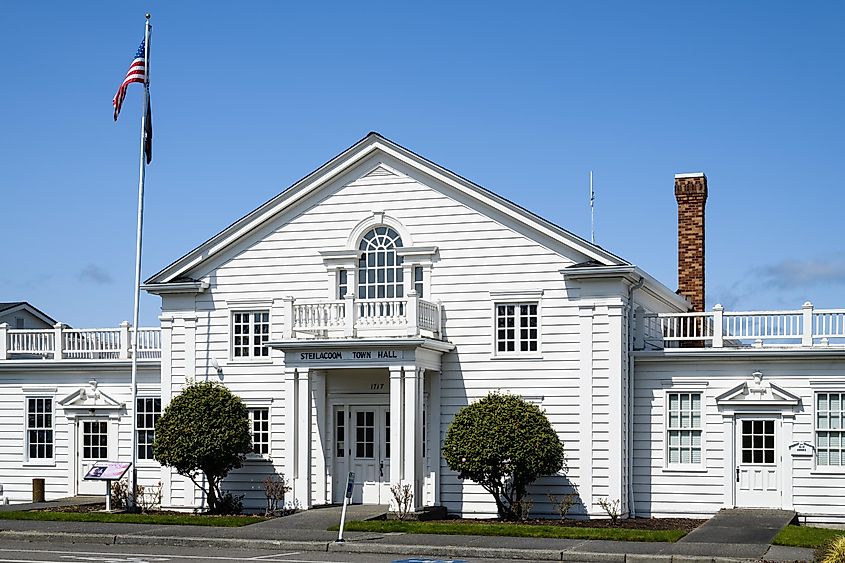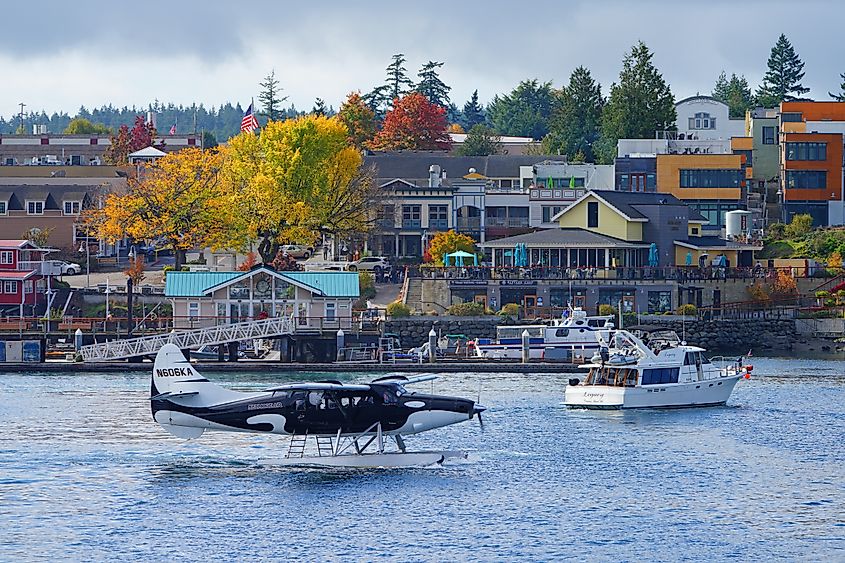
7 Must-See Historic Towns in Washington
Sharing its name with the national capital, Washington is a state full of historical diversity. Often overlooked as a newer settlement, the state overflows with stories of old. From the landing of Spanish Captain Don Bruno de Heceta in 1775 to the Lewis and Clark Expedition in 1805, Washington drew settlers from various countries and industries. Competing and collaborating with Indigenous peoples, these settlers made marks across the developing state, which are preserved today in small communities. These history-filled towns in Washington are a testament to the past, providing visitors with iconic landmarks. Whether this is through Goldendale’s astronomers or the mining past of Molson, history seeps through each alley of these small towns.
Goldendale

Technically a city despite having fewer than 3,500 residents, Goldendale has golden views of outer space. That is why astronomers William Wallace Campbell and Heber Curtis traveled to this southern interior "city" in 1918. They hoped to view a total solar eclipse and test its impact on star light according to Einstein's Theory of Relativity. They succeeded with the former but bungled the latter due to outdated equipment. While the theory was later confirmed, Goldendale's views led to the creation of Goldendale Observatory in 1973, which brought more astronomers to town for another total solar eclipse in 1979. Today, it is part of Goldendale Observatory State Park and is open to the public. Visitors can look through the giant telescope to get a glance into the endless night sky.
Apart from Goldendale’s history with astronomy, the town is home to various historic attractions like the Presby Museum and Maryhill Stonehenge. Yes, there is a Stonehenge replica in southern Washington, which was built in the 1920s to honor the victims of World War One.
Ilwaco

An even smaller city than Goldendale, Ilwaco has about 1,000 residents and occupies the southwest corner of the state. It started as a fishing and logging community and became famous for its Nordic immigrants. By World War One, Ilwaco was reminiscent of a village in Finland, so much so that traditional Finnish saunas ("sauna" is a Finnish word) steamed up the already foggy region. Saunas disappeared when the demographics leveled out, but Ilwaco managed to retain other historic structures from this time. For example, Colbert House is an iconic museum built in the 1870s by some of its first settlers. Here, one can take a look at the town’s fishing past through artifacts, memorabilia, and exhibits.
Being a coastal community, Ilwaco also claims North Head Light, a lighthouse established in 1898. It stands on Cape Disappointment, which was named in 1788 by fur trader John Meares after he failed to identify the mouth of the Columbia River correctly. From touring the lighthouse to hiking along the coast, there are tons of ways to experience the stories. A short walk away lies the iconic Lewis & Clark Interpretive Center, which regales modern travelers with tales from their iconic expedition. Showcasing information on the famed explorers Lewis and Clark, local maritime history, and military history, it is a history lover’s dream.
Edison

Edison, a quaint town in Skagit County, was settled in 1869 as a small community. Many people believe that the town was named after Thomas Edison, but it could also take inspiration from Edison Slough, a small river that still runs through the community of around 240 residents. With that great inventor off the table, Edison's historical claim to fame is the table-making Equality Colony. Founded by Maine socialists, the colony began just outside Edison in 1897 and peaked with hundreds of equally paid members. These included industries like farming, fishing, logging, smithing, woodworking, and even newspaper printing. However, after a series of unfortunate events, including a large fire that destroyed several buildings, Equality Colony closed in 1907. Still, 10 years is an impressive run for a turn-of-the-century utopian experiment.
Although virtually nothing from that colony remains in Edison, stories of the past echo through the streets, creating a rustic charm throughout. Tourists can explore the scenic coastal region where Equality died, which comprises modern Oyster Dome and Dogfish Point. With plenty of hiking trails and beautiful views off the coast, they are perfect for a relaxing day outdoors. After hiking this historic area, they can dine in Edison proper at Mariposa Taqueria restaurant and grab dessert at Breadfarm bakery.
Steilacoom

Incorporated in 1854, 35 years before Washington became a state, Steilacoom is the oldest town in the state. One hundred and seventy years later, many of Steilacoom's oldest buildings are on the National Register of Historic Places. They include Steilacoom Catholic Church, which was built in 1855 as the first Catholic church in the state, and Davidson House, a private home dating back to 1858. These sights are perfect for tours and feel like a trip to the past, with rustic architecture and iconic designs.
Moreover, the town is also home to various museums, such as the Steilacoom Tribal Cultural Center & Museum and the Steilacoom Historical Museum. The Steilacoom Tribal Cultural Center & Museum lies in the former Oberlin Congregational Church from 1903 and exhibits artifacts from Steilacoom's namesake Indigenous stewards. Similarly, the Steilacoom Historical Museum preserves much of the town's other history, but it is in a modern building.
In the modern era, Steilacoom has thrived with over 6,727 residents per the 2020 census. Those not seeing into the past through historic attractions opt to spend the day at outdoor areas like Sunnyside Beach and Pioneer Orchard Park. Whether it is enjoying a relaxing picnic along the water or playing volleyball in the sand, there are lots of ways to have fun.
Molson

With no census counts for many years, Molson is likely a ghost town. Yet tourists flock to that part of extreme northern Washington for precisely that reason. Because, although it is bereft of people, Molson is spiritually thriving due to its wealth of historic haunts dating back to its boomtown days. Like many early American towns that subsisted on a single industry, Molson flourished for a short time until its industry died. In this case, it was mining. By the 1930s, Molson was on life support. Today, it is the lively Old Molson Historic Site, an open-air museum of a pioneer town unchanged (at least on the outside) for over a century. Visitors can tour in and out of the Molson State Bank from 1908, the Sherling Family House from 1898, the Assay Office from 1896, and several other heritage buildings. Displaying rustic architecture and tales of old, these spots transport one to an era of the past. Perhaps most interesting of all, Molson was funded by the Canadian Molson beer-brewing family. Thus, tourists can buy their namesake ale right over the border in British Columbia.
Friday Harbor

Spend more than just Friday in Friday Harbor, a seaside town of roughly 2,600 people on San Juan Island. Among its delectable and debonair destinations are historic gems like the San Juan Historical Museum and The Whale Museum. The former is an eight-building exhibit on the grounds of the former James King farm, which began in the late 1800s and encompassed 445 acres. The latter is America's first museum devoted to wild orcas, which have been staples of the surrounding waters since before Friday Harbor, before the Hudson's Bay Company, before Spanish explorers, and before Indigenous seafarers. But the craziest island history is preserved at San Juan Island National Historical Park, the site of the Pig War, an 1859 territorial dispute between America and Britain spurred by the shooting of a British-owned pig. Although it was a 12-year conflict with camps primed for warfare, the pig was the only casualty. Some might say it was a cold-cuts war.
Beyond the past, Friday Harbor is a lovely waterside destination, home to plenty of tourist attractions. Most people love to spend the day at Lime Kiln State Park, where hiking trails and rocky bluffs provide an overlook to watch over the local favorite orca whales. After a day outdoors, Spring Street is loaded with cafes and restaurants like the Coho Restaurant, for a great meal to end the day.
Neah Bay

Neah Bay is a small community on the Makah Reservation in extreme northwest Washington. Said to be named for a 16th-century Makah chief, it is a trove of ancient Indigenous treasures, most of which are from nearby Ozette Native American Village Archeological Site. This village was buried by a mudslide hundreds of years ago and rediscovered in the late 1960s. Archaeologists unearthed over 55,000 artifacts here, including houses, harpoons, clubs, knives, dishes, baskets, and other signatures of prehistoric and historic coastal societies. Many of these are now housed at Neah Bay's Makah Museum, where visitors can learn about the tribal culture. Neah Bay also contains Fort Núñez Gaona, a monument for a Spanish fort built in 1792 as one of the first non-Native settlements in the Pacific Northwest. If you have time, continue on and hike to the site of an 1834 Japanese shipwreck for even more historical diversity.
Parallel to the historical influence, Neah Bay’s coastal location is coveted by sport fishermen. Whether it is casting a line into the Pacific Ocean or driving over to the Strait of Juan de Fuca, there are regular opportunities across the coastline. Moreover, with all sorts of fish like sea bass, salmon, and lingcod, it is a fisherman’s dream.
The Evergreen State has evergreen attractions, especially in and around its small communities. Goldendale, Edison, Ilwaco, Steilacoom, Molson, Friday Harbor, and Neah Bay are scenic Washington settlements abounding with historic sites. Tourists adore the array of rustic landmarks, from lighthouses and archeological dig sites to ghost districts that beckon the curious. To this end, history enthusiasts flock to Washington and the stories hidden behind its lovely small towns.











